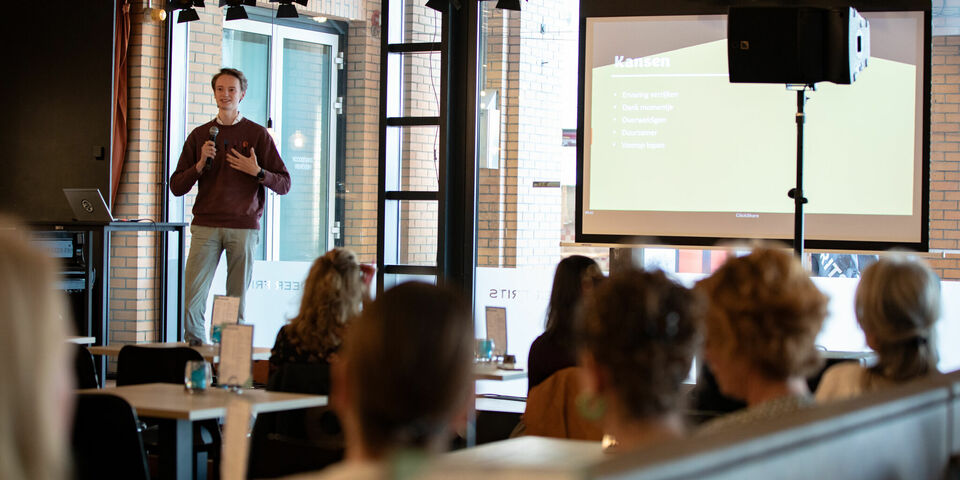Muziekgebouw to do away with bouquets - but how?
Thanking musicians with a bouquet of flowers after their concert is a nice gesture, but Muziekgebouw Eindhoven feels that the cut flowers industry is no longer in line with its sustainability goals. In order to find an alternative, the organization contacted TU/e lecturer Lenneke Kuijer, who set students in her ID Green course the task of coming up with an alternative. On Tuesday, the most original concepts were presented by the students. The ideas presented to Muziekgebouw include ceramic thank-you tiles, a light show and seed paper.
“A bouquet of flowers from a heated greenhouse or flown in by plane from far away has a considerable climate impact,” says Jessica Dassen, Inclusion & Sustainability programmer at Muziekgebouw Eindhoven. She knows that 312 bouquets of flowers are handed out there every year, causing over 4 kilos of CO2 emissions per bouquet. “So that causes an annual emission of at least 1248 kilos of CO2. Not to mention the environmental problems caused by water use and pesticides.”
Another problem with flower bouquets is that touring musicians often do not get the chance to give them a nice spot at home, because they’re traveling and staying in a tour bus or hotel. On top of that, the product is very perishable. Dassen joined forces with lecturer Lenneke Kuijer, who teaches the course ID Green: Design Perspectives on Sustainability.
Concepts
Thirty interested people have gathered in café Meneer Frits - press and concert hall employees - to listen to two ideas presented by three students. “Ten groups came up with a concept and the four most original ones were invited to this presentation, but it’s also exam week,” says lecturer Kuijer, explaining the low turnout of her students. She also emphasizes that the students only had two weeks to develop their idea.
Julia Klappe and Femke van de Vijver came up with the “Tile of gratitude”. During their slick presentation on stage, they tell about their idea of presenting conductors or soloists with hexagonal tiles as a thank-you gift. “Instead of flowers, the Muziekgebouw employee offers them a black tile in a pretty, reusable box. They may then sign the tile, right there before the eyes of the audience, with a white marker. The tile already has a sticker on it with the name and date of the concert. This could make for a beautiful ceremony and when the conductor shows the tile to the audience, they will once again applaud.”
That tile is then placed on one of the walls of Muziekgebouw, for example next to the stairs. This way, attendees will have something to remind them of the concert on subsequent visits and others will get to see what they missed. The students also calculated the costs of the material. “The price of ceramic tiles is 50 cents each, and they can be reused. A cutting plotter for the labels can be purchased with a one-time investment of 400 euros.”
The musicians of OrkestZUID, whose Mahler concert all students got to attend on June 17 as a thank you for presenting their ideas, responded positively. However, Klappe and Van de Vijver acknowledge that more research is needed. “Two weeks was too short a time to speak to more orchestra members, to figure out exactly how to stick the tiles to the wall and to find out if the audience will truly feel a sense of engagement.”
Light show
Student Sebas Ropers (see main photo) and his group came up with “Shine”. Shine is a light system that responds to the audience’s applause. “We didn’t think of an alternative, but an improvement,” he says. “Shine uses the lights that are already there and monitors the applause. It converts the data into corresponding colors and pulses.” This technology-driven solution raises a question among the attendees. “How does the audience know that that’s how it works, that their behavior controls the lights?” That will be explained on the ticket, Ropers states. “We’re also considering a transition period of a year and a half during which there will be an interactive light show in addition to the bouquets.”
Lecturer Kuijer presents two more concepts from students who are not present. These involve Flower cards made of biodegradable paper containing seeds and old light bulbs that are used to store seeds which musicians can sow at home. Several groups explored the idea of seed paper, Kuijer noted.
Sustainability programmer Jessica Dassen agreed in the Green Stages Covenant that Muziekgebouw aims for circular operations by 2030. “This morning, we were given homework for the summer to make a good choice. We will get back to this and for now, we are happy with the ideas.”



Discussion